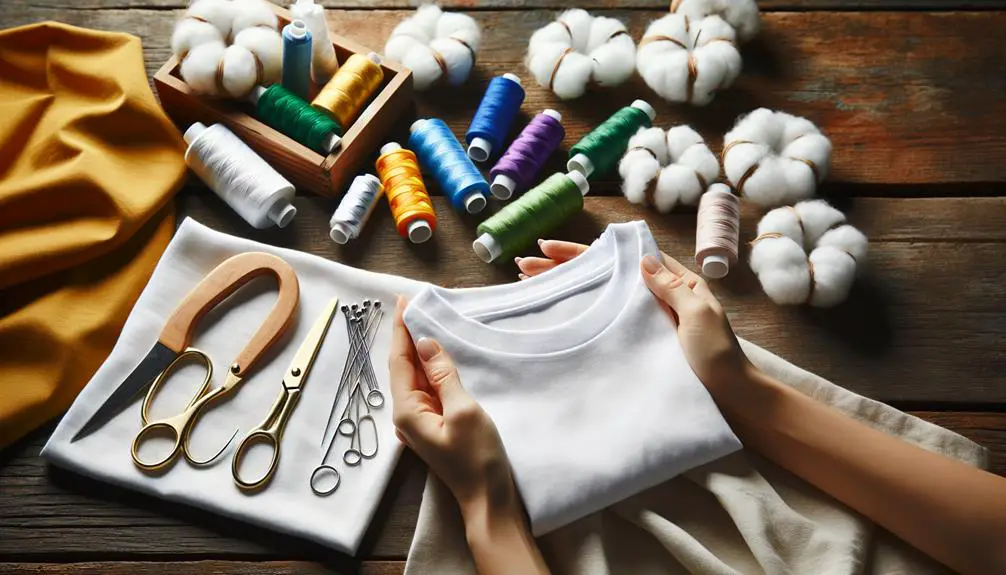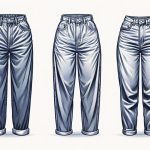I gotta say, the most common use for cotton is in the textile and clothing industry. It rules the market because it's comfy, tough, and can do it all. From soft tees to long-lasting jeans, cotton is king. And if you wanna know more about why cotton is such a big deal in other cool areas, just keep discovering!
Table of Contents
Key Takeaways
- Cotton is most commonly used in the textile and clothing industry for soft and durable apparel.
- It dominates the market in home and personal care products like towels, sheets, and curtains.
- Cotton is essential in medical supplies for wound care due to its absorbency and hypoallergenic properties.
- Industrial and agricultural applications of cotton include textile manufacturing and livestock feed.
- Cotton is popular in bedding and linens for its softness, breathability, and hypoallergenic qualities.
Textile and Clothing Industry
Within the textile and clothing industry, cotton stands out as a versatile and essential material, with U.S. textile mills alone consuming approximately 7.6 million bales of cotton each year. These cotton fibers are the building blocks of many items we wear daily, from the softest t-shirts to the most durable jeans. The beauty of cotton lies in its ability to be transformed into a wide array of textiles, making it a favorite among designers and consumers alike.
Cotton fibers aren't only comfortable to wear but also highly absorbent, making them perfect for items like towels and bed linens. The natural breathability of cotton also makes it ideal for clothing, allowing air to flow through and keeping us cool on warm days.
Whether you're lounging in your favorite cotton pajamas or heading out in a crisp cotton shirt, the impact of cotton fibers on our daily lives is undeniable. The textile and clothing industry rely heavily on the versatility and comfort that cotton provides, making it a staple in our wardrobes.
Home and Personal Care Products
Cotton's versatility extends beyond the textile and clothing industry into a variety of home and personal care products, playing a key role in items like bedspreads, towels, and even healthcare products. When it comes to home furnishings, cotton is a top choice for many reasons. Let me break it down for you in a simple table:
| Home Furnishing | Market Share | Key Role |
|---|---|---|
| Towels and Washcloths | Nearly 100% | Due to absorbent qualities |
| Sheets and Pillowcases | Over 60% | Preferred material for comfort |
| Curtains and Carpets | Significant share | Known for durability and style |
As you can see, cotton dominates the market in towels and washcloths due to its absorbency, while also being a preferred choice for sheets and pillowcases for its comfort. Additionally, cotton's durability and style make it a popular option for curtains and carpets to enhance the look of your home.
Medical and Hygiene Supplies
Cotton plays a vital role in medical and hygiene supplies like surgical dressings and personal care products. Its absorbent and hypoallergenic properties make it ideal for wound dressing and skincare applications.
Utilizing cotton guarantees comfort and safety in these essential healthcare and personal care items.
Surgical Dressings
Surgical dressings play an essential role in wound care by utilizing cotton as a primary material due to its absorbency and hypoallergenic properties. Cotton is widely used in medical supplies like bandages and wound dressings, ensuring comfort and effectiveness in healing.
The absorbent nature of cotton aids in maintaining a dry environment around the wound, promoting faster recovery. Additionally, cotton's hypoallergenic properties make it suitable for sensitive skin types, reducing the risk of irritation or allergic reactions.
Personal Care Products
When it comes to personal care products, whether for medical needs or general hygiene, cotton stands out as a versatile and indispensable material. Cotton is a primary component in various items we use daily, from bandages for wound dressing to beauty products like sheet masks and makeup remover wipes. Its natural properties make it ideal for creating hygiene products such as first aid kits and beauty essentials. In the table below, I've summarized some key uses of cotton in personal care products:
| Personal Care Products | Cotton Application |
|---|---|
| Bandages | Primary material for wound dressing |
| Beauty Products | Used in sheet masks and makeup remover wipes |
| Hygiene Supplies | Essential component in first aid kits and beauty items |
| Medical Supplies | Key role in producing swabs and x-rays |
Industrial and Agricultural Applications
I'm excited to talk about how cotton plays a big role in industrial and agricultural settings. From textile manufacturing to farming practices, cotton has diverse applications.
Let's explore how this versatile material contributes to oil and fuel production, as well as its benefits for soil health.
Textile Manufacturing Uses
Cotton plays a crucial role in textile manufacturing, serving as a primary ingredient in various industrial and agricultural applications. In textile mills, cotton is transformed into a wide range of products that we use daily.
Here are some key uses of cotton in textile manufacturing:
- Apparel: Cotton is a popular choice for clothing due to its softness, breathability, and durability.
- Home Furnishings: Cotton is used in items like bed sheets, towels, and curtains, adding comfort and style to our homes.
- Industrial Products: Cotton finds its way into industrial goods such as medical supplies, tarpaulins, and wall coverings, showcasing its versatility and utility in various sectors.
Farming and Soil
Enhancing agricultural practices, cotton contributes significantly to soil enrichment and serves diverse industrial and agricultural purposes. Cotton stalks play an important role by enriching the soil and are utilized in making paper and cardboard.
Additionally, cottonseed serves as a valuable protein source for livestock such as cattle and horses in agriculture. The byproducts of cotton, including cotton meal and hull, are essential components in fertilizers, aiding in plant growth and soil quality.
Furthermore, cotton linters find applications in various products like medical supplies, mattresses, and flat-screen televisions. The global production of cotton seeds not only benefits agriculture but also provides protein for millions of people worldwide through its industrial and agricultural uses.
Oil and Fuel
Utilizing cottonseed for oil and fuel applications plays an indispensable role in various industrial and agricultural processes. Cottonseed oil is a versatile product that finds its way into many everyday items. Here are some key points about cottonseed oil:
- Industrial Applications: Cottonseed oil is used in the production of soap, cosmetics, and pharmaceuticals.
- Cooking and Food Preparation: It's a popular choice for cooking due to being cholesterol-free and rich in polyunsaturated fats.
- Livestock Feed: Cottonseed meal, a byproduct of oil extraction, is a valuable high-protein feed source for animals like cows and chickens.
Cottonseed not only benefits industries but also plays an essential role in providing essential resources for agriculture and livestock.
Bedding and Linens
Embracing the comforting embrace of cotton bedding and linens elevates the quality of rest and relaxation in any bedroom. Cotton is a favorite choice for bedding and linens, dominating over 60% of the sheets and pillowcases market. Its softness, breathability, and hypoallergenic properties make it a top pick for various home furnishings. Let's take a closer look at how cotton shines in the world of bedding and linens:
| Cotton in Bedding and Linens | Market Share |
|---|---|
| Sheets and Pillowcases | Over 60% |
| Bedspreads | High demand |
| Towels and Washcloths | Almost 100% absorbency market share |
| Window Shades | Popular choice |
| Comfort and Durability | Key attributes |
Cotton's absorbent nature makes it the go-to material for towels and washcloths, with nearly 100% of the market supplied by cotton. Whether it's the crisp coolness of cotton sheets or the plush comfort of cotton towels, this natural fiber truly enhances the sleeping and bathing experience.
Apparel and Accessories
Cotton plays a vital role in the apparel and accessories industry, especially in men and boys clothing, where it accounts for over 70% of cotton's usage. When you think about men's and boys' clothing, chances are high that cotton is the fabric of choice.
Here are a few key points highlighting the significance of cotton in the apparel industry:
- Versatility: Cotton is incredibly adaptable and can be found in a wide range of clothing items, from jeans to shirts and even underwear.
- Comfort: One of the main reasons cotton is preferred in the apparel industry is the comfort it provides. Its softness and breathability make it ideal for everyday wear.
- Market Dominance: Cotton isn't just popular; it's dominant in the apparel market, with a share that continues to grow, particularly in retail apparel and home furnishings.
With its comfort, versatility, and market prevalence, it's no wonder that cotton remains a staple in the apparel industry for men and boys alike.
Nonwoven Fabrics
Nonwoven fabrics made from cotton have some cool uses that are worth mentioning. They're versatile in applications and are produced sustainably, which is pretty neat.
Let's explore more about these fascinating aspects!
Versatile Applications
Utilizing cotton fibers in fabric production offers a wide range of versatile applications, particularly in the creation of nonwoven materials for various everyday products. Nonwoven cotton fabrics are essential components in many items we use daily due to their softness and vital properties.
- Hygiene Products: Cotton-based nonwoven fabrics are commonly used in diapers and feminine care items.
- Comfort and Absorbency: Cotton fibers provide comfort, breathability, and excellent absorbency in nonwoven products.
- Everyday Essentials: Nonwoven cotton fabrics play a vital role in items like wipes, bandages, and filters, making them indispensable in our daily lives.
Sustainable Production
Choosing sustainable practices in fabric production involves harnessing the natural properties of cotton to create eco-friendly nonwoven fabrics that minimize environmental impact. Cotton-based nonwoven fabrics offer a biodegradable and renewable alternative to traditional materials, supporting the shift towards a more eco-conscious textile industry.
By utilizing cotton in nonwoven fabric production, we not only benefit from its inherent sustainability but also contribute to the circular economy through promoting recycling and reusability. These fabrics embody a commitment to reducing waste and lessening our carbon footprint, making them an essential component of a more environmentally friendly approach to textile manufacturing.
Embracing cotton-based nonwoven fabrics is a significant step towards a more sustainable future in the fashion and textile sectors.
Innovation in Cotton Usage
Innovations in cotton usage have revolutionized the sustainability and versatility of this natural fiber. Companies like Barnhardt Cotton are at the forefront of showcasing innovative practices in the cotton industry, driving advancements in how cotton is used.
Here are some key ways in which cotton is being innovatively utilized:
- Sustainable Nonwoven Products: Cotton innovation now extends to creating sustainable nonwoven products, offering eco-friendly alternatives in various domains.
- Cotton Processing Advancements: The cotton processing sector has seen significant advancements, especially in prepping and processing at the cotton gin, enhancing efficiency and quality.
- Natural Hygiene Products: Cotton's innovative uses extend to the sphere of natural hygiene products, where it's being incorporated into items that promote consumer health and well-being.
With its inherent versatility, cotton continues to inspire new applications and products, driving a wave of innovation across various sectors.
Sustainability in Cotton Production
In sustainable cotton production, the focus lies on minimizing environmental impact while promoting ethical practices throughout the supply chain. Sustainable cotton farming practices play an essential role in reducing the overall environmental footprint of cotton cultivation. Compared to other crops, cotton's water usage of 1,062 gallons per pound is relatively important. By implementing sustainable farming methods, such as reducing water consumption and limiting pesticide use, the environmental impact of cotton production can be greatly decreased.
Moreover, sustainable cotton production is dedicated to safeguarding biodiversity, ensuring fair labor conditions, and enhancing soil health. Organic cotton cultivation, for instance, refrains from using synthetic pesticides and fertilizers, which not only boosts soil fertility but also minimizes environmental harm. Certifications like GOTS and Fair Trade further guarantee that ethical and environmentally friendly practices are maintained across the cotton supply chain. Embracing sustainability in cotton production is essential for preserving our environment and promoting social responsibility within the industry.
Global Economic Impact
The global impact of cotton on economies worldwide is substantial, particularly within the textile industry where cotton is a major consumer product. Cotton fiber is a versatile and in-demand material that greatly influences global economic activities. Here are some key points to ponder:
- Textile Industry Dependency: The global textile industry heavily relies on cotton fibers for the production of various goods, ranging from clothing and home textiles to medical supplies.
- Economic Contribution: Cotton production and trade play an essential role in the global economy, generating revenue streams for countries involved in cultivation, processing, and export of cotton products.
- Development Impact: Cotton's economic significance extends to the development of many nations, as it creates employment opportunities, drives innovation in textile manufacturing, and fosters economic growth in cotton-producing regions.
Frequently Asked Questions
What Is the Main Product of Cotton?
The main product of cotton is cotton lint. It's versatile, used in clothing, homewares, and industrial goods. From fabrics like velvet to products like fishnets, cotton lint serves a wide range of purposes, showcasing its adaptability.
Why Is Cotton Widely Used?
Cotton is widely used because of its versatility across industries. Its natural properties like comfort and absorbency make it a preferred choice for clothing and household items. The market share of cotton has escalated notably.
Why Is Cotton so Commonly Used in the World Today?
Cotton's ubiquity stems from its versatility, comfort, and sustainability. Its natural properties make it ideal for clothing, bedding, and textiles. As a result, it's widely used in the textile industry for apparel, home goods, and more.
What Is an Example of Use for Cotton?
Cotton is versatile, finding its way into apparel, home furnishings, and industrial products. Its popularity is evident in items like jeans, towels, and medical supplies. The market embraces cotton for its comfort and practicality.
- The History and Evolution of Chamois Fabric - June 22, 2025
- Chamois Fabric on Wikipedia: What You Need to Know - June 22, 2025
- How to Pronounce Chamois Fabric Correctly - June 22, 2025






